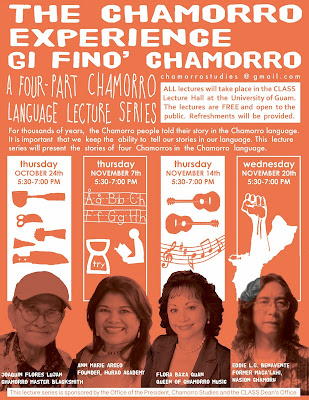The Chamorro Experience gi Fino' Chamorro
For thousands of years the Chamorro people have used the Chamorro language to tell their complicated story.
When Magellan arrived in ships filled with starving and
sickly sailors, Chamorros greeted him in the Chamorro language. When the
Spanish and other Europeans stopped in Guam to trade with Chamorros bits of
iron for rice, water and fruits, Chamorros greeted them in Chamorro. Even
during the Spanish Chamorro Wars, both those who fought against the Spanish
such as Hurao, Agualin or Chelef did so in Chamorro, giving grand speeches
trying to inspire courage. But even those who sided with the Spanish, like
Hineti and Ayihi and pledged their spears to defend the earthly representatives
of an invisible deity they had just met, they did so in the Chamorro language.
Even as Chamorros started to become Catholic and accept the
new faith in their lives, they used Chamorro, albeit infused with some Spanish,
in order to experience their religion. When the Americans arrived replacing one
colonizer with another, Chamorros learned a new language, but kept to their
own. They talked about the new opportunities the Americans were bringing, but
also complained about their racism and discrimination all in the Chamorro
language.
During the Japanese period the language was once again a
shield. At a time when not bowing properly to a Japanese soldier could get you
beaten, the Chamorro language provided a means of expressing oneself while
protecting yourself. Chamorros created songs that mocked the Japanese and would
sometimes sing them within earshot, leaving the Japanese to question in
ignorance whether the song was offensive or not.
Even in the time before colonizers, the Chamorro language
was still there. It was the soundtrack to the erecting of latte homes, of
voyages across oceans, battles between villages, and the venerating of
ancestors.
Since World War II the language has declined rapidly. It is
no longer actively being spoken to younger generations. Today, Chamorros use
English as the primary means of expressing themselves and talking about their
experiences. For most Chamorros born after World War II, the language exists,
and they hear it and may even use it in some ways, but it is fundamentally divorced
from their experiences. For describing their daily lives, their desires, their
emotions, their goals, English feels more comfortable.
The Chamorro language has long been used to tell our story,
but it also represents in and of itself, our story and our history. The
Austronesian roots, the core of the language still persists, but other
languages have changed it and influenced it as well. It is the sum of all our
complicated parts. To use contemporary Chamorro means to use a living
linguistic organism that connects you to people in Europe, Asia and the
Pacific. From a language, we can analyze the values of a people, their
psychology and epistemology.
The Chamorro language has for thousands of years been the
means through which Chamorros connected to each other and to the world. It
survived and adapted as the Chamorro people survived and adapted. It is truly
tragic to see that within a few generations it may disappear. When our manamko’
today pass on, they will take most of the language with them, since they did
not actively pass it on to the generations that followed them. To go from 100%
fluency to 4% fluency in three generations means that a language will be alive
and vibrant only as long as that generation of manamko’ is around. Once they pass
on, the Chamorro language will go the way of the songs of native birds, it will
be quieted and eventually close to silence.
It is important that we teach it to our children and support
their learning it and using it. It is imperative that we keep the ability to
tell our stories in the Chamorro language.
This week the University of Guam President’s Office and
Chamorro Studies program are premiering a new lecture series, a Chamorro
language lecture series. Its title, “The Chamorro Experience gi Fino’
Chamorro.”
Over the course of the next month, we will host four
Chamorro language lectures, each from a Chamorro who will talk about their
experiences and their perspectives. They come from very different walks of life
and very different perspectives, and the focus is not necessarily on the
Chamorro language, but rather the nexus between their experiences and the
Chamorro language. Having a lecture series like this won’t “save” the Chamorro
language, but if it can inspire some fluent Chamorro speakers in the audience
to use it more around those younger than them, or inspire some young would-be
speakers to really commit to learning and using the language, then the series
will be well worth it.
Our first speaker is Tun Jack lujan, the Chamorro Master
Blacksmith. On October 24th, at 5:30 pm at the CLASS Lecture Hall in
the University of Guam he will be giving a lecture on the Chamorro traditional
tools to which he has devoted his life to preserving and promoting. The
lectures are free and open to the public and some refreshments will be
provided. Following the lecture a Q and A session will take place.
The remaining speakers are: Ann Marie Arceo, founder of Hurao Academy (11/7), Flora Baza Queen, Queen of Chamorro Music (11/14) and Eddie LG Benavente, former Maga'lahi of Nasion Chamoru (11/20).




Comments